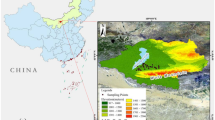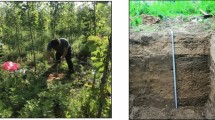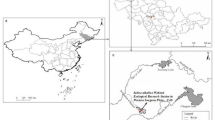Abstract
The particle size distribution in small watershed changes under different land uses and affects soil erodibility. The aims of this study were (1) to investigate the volume fractal dimension of particle size distribution under different land uses in a typical small watershed of purple soil, (2) to estimate soil erodibilities of various land uses utilizing the Erosion-Productivity Impact Calculator (EPIC) model and the nomogram (NOMO) model, and (3) to relate volume fractal dimension with the soil erodibility used in the Universal Soil Loss Equation (USLE) in purple soil areas. Laser diffractions and double-logarithmic model were used to measure and calculate volume fractal dimension values. The results show that soil volume fractal dimensions were well linearly fitted to the double-logarithmic model with high correlation coefficients of 0.902–0.936 under six land uses in the small watershed. The averaged volume fractal dimension values under different land uses, from high to low were in the order of Zea mays L, Ipomoea batatas, Citrus reticulata Blanco, Setaria viridis, Robinia pseudoacacia L, Pinus massoniana Lamb. The volume fractal dimension was positively correlated to clay particle fraction (R = 0.933). The average soil erodibility values under different land uses from high to low were in the order of Setaria viridis, Citrus reticulata Blanco, Pinus massoniana Lamb, Zea mays L, Ipomoea batatas, Robinia pseudoacacia L while average soil erodibilities from high to low values were in the order of Setaria viridis, Citrus reticulata Blanco, Zea mays L, Ipomoea batatas, Pinus massoniana Lamb, Robinia pseudoacacia L. The soil erodibilities calculated by the two models were similar, and positively correlated (R = 0.630–0.877). The volume fractal dimension values of six land uses were negatively correlated to both soil erodibility estimated by EPIC and by NOMO models. Moreover, the correlations of the volume fractal dimension values of Zea mays L, Ipomoea batatas and Citrus reticulata Blanco estimated by EPIC or NOMO were lower than those of Pinus massoniana Lamb, Robinia pseudoacacia L and Setaria viridis. Further research is needed to determine the influence of volume fractal dimension on the soil erodibility under different land use and managements.





Similar content being viewed by others
References
Adolfo ND, Daniel G, Marco B, Carlos MP, Markus F (2001) Multifractal characteristics of soil particle size distribution. Soil Sci Am J 65:1361–1367
Adolfo ND, Daniel G, Roberto Q, Richard P (2003) Multifractal characteristics of soil pore system. Soil Sci Am J 67:1361–1369
Arya LM, Heiman JL, Thapa BB, Bowman DC (2010) Predicting saturated hydraulic conductivity of golf course sands from particle size distribution. Soil Sci Am J 74:33–37
Caniego FJ, Espejo R, Martin MA, Jose FS (2005) Multifractal scaling of soil spatial variability. Ecol Model 182:291–303
Chen LD, Fu BJ, Xu JY, Gong J (2003) Location-weighted landscape contrast index: a scale independent approach for landscape pattern evaluation based on “source-sink” ecological processes. Acta Ecologica Sinica 23:2406–2413
Chen LD, Fu BJ, Zhao WW (2006) Source-sink landscape theory and its ecological significances. Acta Ecologica Sinica 26:1444–1449
Cheng XF, Shi XZ, Wang HJ (2003) Fractal characteristics of particle of Arable Layers in Hilly Region of red soil. Scientia Geographica Sinica 23:617–621
De Vente J, Poesen J, Verstraeten G, Van Rompaey A, Govers G (2008) Spatially distributed modelling of soil erosion and sediment yield at regional scales in Spain. Glob Planet Change 60(3–4):393–415
Falconer KJ (1989) Fractal geometry. Wiley, Chichester, pp 89–159
Fu BJ, Xu YD, Lv YH (2008) Scale characteristics and couple research of landscape pattern and soil and water loss. Adv Earth Sci 25:673–681
Hu JZ, Zhang WH, Li WZ (2004) Effect of plant community on anti-erodibility of land under rehabilitation in BeiChuanHe basin. Acta Pedol Sin 41:854–863
Huang GH, Zhang WH (2002) Fractal property of soil particle size distribution and its application. Acta Pedol Sin 4:490–497
Institute of Soil Science, Chinese Academy of Science (1978) Measurement method of soil physicochemical properties. Science Press, Bei**g
Institute of Soil Science, Chinese Academy of Science (1980) The analysis of soil physicochemical properties. Shanghai Scientific and Technical Publishers, Shanghai
Liu BY, **e Y, Zhang KL (2001) The soil erosion model. Science Press, Bei**g, pp 65–88
Mandelort BB (1977) Form chance and dimension. Freeman, San Francisco, pp 1–234
Mandelort BB (1982) The fractal geometry of nature. Freeman, San Francisco, pp 45–256
Martin MA, Montero E (2002) Laser diffraction and mutifractal analysis for the characterization of dry soil volume-size distribution. Soil Tillage Res 64:113–123
Miao CY, Ni JR, Borthwick AGL (2010) Recent changes in water discharge and sediment load of the Yellow River basin, China. Prog Phys Geogr 34(4):541–561
Miao CY, Ni JR, Borthwick AGL, Yang L (2011) A preliminary estimate of human and natural contributions to the changes in water discharge and sediment load in the Yellow River. Glob Planet Change 76(3–4):196–205
Miao CY, Duan QY, Yang L, Borthwick AGL (2012) On the applicability of temperature and precipitation data from CMIP3 for China. PLoS ONE 7(9):e44659. doi:10.1371/journal.pone.0044659
Millan H, Gonzalez P, Aguilar M, Dominguez J, Cespedes L (2003) On the fractal scaling of soil data particle-size distribution. Geoderma 117:117–128
Perfect E, Kay BD, Rasiah V (1993) Multifractal method for soil aggregate fragmentation. Soil Sci Am J 57:896–900
Prosperinin N, Perugini D (2008) Particle size distributions of some soil from the Umbria Region (Italy): fractal analysis and numerical modeling. Geoderma 145:185–195
Rieu M, Sposito G (1991) Fractal fragmentation soil porosity and soil water properties. Application. Soil Sci Am J 55:1231–1238
Segal E, Shouse PJ, Bradford SA, Skaggs TH, Corwin DL (2009) Measuring particle size distribution using laser diffraction: implications for predicting soil hydraulic properties. Soil Sci 174:639–645
Shi XZ, Yu DS, Lu XX (1995) Study on soil erodibility by using rainfall simulator in subtropic China. J Soil Eros Soil Water Conserv 9(3):38–42
Su YZ, Zhao HL (2004) Fractal features of soil particle size distribution in the desertification process of the farmland in Horqin Sandy land. Acta Ecologica Sinica 24:71–74
Tyler SW, Wheatcraft SW (1989) Application of fractal mathematics to soil water retention estimation. Soil Sci Am J 53:987–996
Tyler SW, Wheatcraft SW (1992) Fractal scaling of soil particle size distributions: analysis and limitations. Soil Sci Am J 56:362–369
United States Department of Agriculture (USDA) (1951) Soil survey manual. U.S. Dept. Agriculture Handbook No. 18, Washington DC, USA
Vanelslande A, Rousseau P, Lal R, Gabriels D, Ghuman BS (1984) Testing the applicability of a soil erodibility nomogram for soil tropical soils. Chall Afr Hydrol Water Resour 144:463–473
Wang GL, Zhou SL, Zhao QG (2005) Volume fractal dimension of soil particles and its application to land use. Acta Pedol Sin 42:546–550
Wang D, Fu BJ, Zhao WW, Hu HF, Wang YF (2008) Multifractal characteristics of soil particle size distribution under different land-use types on the Loess Plateau, China. Catena 72:29–36
Wei CF, **e DT, Chen FC (1989) Study on purple soil particles and chemical component in South Sichuan Basin. J Southwest Agric Univ 11:425–428
Williams JR, Sharply AN (1990) EPIC-erosion productivity impact calculator. Model Documentation USDA of Agricultural Technical Bulletin, no. 1768
Wischmeier WH, Smith DD (1978) Predicting rainfall erosion losses. A guide to conservation planning. USDA, ARS, Agricultural Handbook, Washington, DC, no. 53
Wischmeier WH, Johnson CB, Cross BV (1971) A soil erodibility nomograph for farmland and construction cites. J Soil Water Conserv 26:189–193
Wu CZ, Hong W (1999) Study on fractal features of soil aggregate structure under different management patterns. Acta Pedol Sin 36:162–167
Wu Q, Borkovec M, Sticher H (1993) On particle-size distribution in soil. Soil Sci Am J 57:883–889
**a L, Zhang GC, Heathman GC, Wang YQ, Huang CH (2009) Fractal features of soil particle size distribution as affected by plant communities in the forested region of Mountain Yimeng, China. Gederma 154:123–130
Yang PL, Luo YP, Shi YC (1993) The description of the soil fractal characterization based on weight distribution of the particle size. Chin Sci Bull 38:1896–1899
Yang JL, Li DC, Zhang GL (2008) Comparison of mass and volume fractal dimensions of soil size distributions. Acta Pedol Sin 45:413–419
Zhang KL, Peng WY, Yang HG (2007) Soil erodibility and its estimation for agricultural soil in China. Acta Pedol Sin 44:7–13
Zhang JC, Li HD, Lin J (2008a) Spatial variability of soil erodibility (K-factor) at a catchment scale in China. Acta Ecologica Sinica 28:2199–2206
Zhang Z, Wei CF, **e DT, Gao M, Zeng XB (2008b) Effect of land use patterns on soil aggregate stability in Sichuan Basin, China. Particuology 6:157–166
Zhao WZ, Liu ZM, Cheng GD (2002) Fractal dimension of soil particle for sand desertification. Acta Pedol Sin 39:877–881
Zhu XM (1960) The effect of vegetation in Loess areas on the soil erosion. Acta Pedol Sin 8:17–21
Acknowledgments
This study was financially supported by the Fundamental Research Funds for the Central Universities (XDJK2011C013), National Technology Support Program (2011BAD31B03); Postdoctoral Science Foundation for Southwest University (SWU110023); Construction Funds for Ecology Key Disciplines for Project 211 Southwest University, National Key Basic Special Foundation Project of China (2010CB95160402).We are also grateful for the comments and criticisms of the journal’s anonymous reviewers.
Author information
Authors and Affiliations
Corresponding author
Rights and permissions
About this article
Cite this article
Chen, X., Zhou, J. Volume-based soil particle fractal relation with soil erodibility in a small watershed of purple soil. Environ Earth Sci 70, 1735–1746 (2013). https://doi.org/10.1007/s12665-013-2261-y
Received:
Accepted:
Published:
Issue Date:
DOI: https://doi.org/10.1007/s12665-013-2261-y




